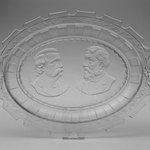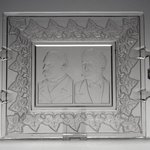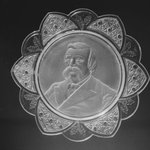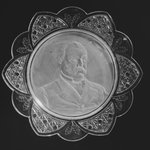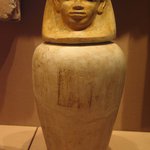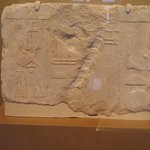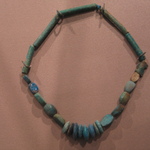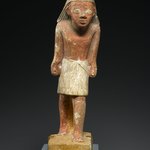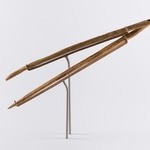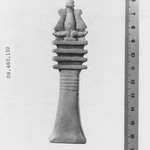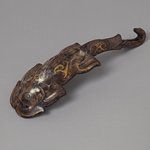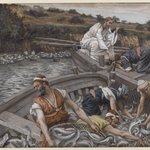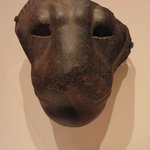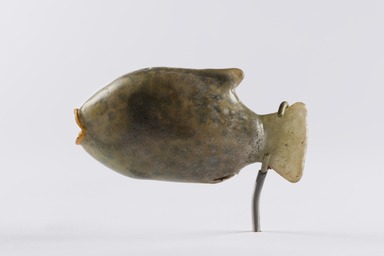

Fish Flask, ca. 1390–1292 B.C.E. Glass, 2 1/4 × 4 3/8 × 1 5/8 in. (5.7 × 11.1 × 4.1 cm). Brooklyn Museum, Charles Edwin Wilbour Fund, 37.316E. Creative Commons-BY (Photo: Brooklyn Museum, 37.316E_overall_PS22.jpg)
Fish Flask
Egyptian, Classical, Ancient Near Eastern Art
Vessels
Ancient Egyptian artists produced vessels in both glass and faience, producing different effects with each material.
The Egyptians began manufacturing glass vessels during the Eighteenth Dynasty reign of Thutmose III (circa 1479–1425 B.C.E.). Early examples, valued for their rarity and beauty, were luxury items used to store precious oils and perfumes. Craftsmen produced striking effects by adding threads of colored glass to a vessel’s surface while it was still hot and then dragging a pointed object across the surface to produce festooned patterns. The artist who made the fish flask shown here indicated the animal’s scales by pressing blue powdered glass down into the interior.
Early scholars often incorrectly characterized faience as simply an inexpensive substitute for glass, but recent research suggests that the Egyptians favored the material because of its attractive color and its association with water, the source of creation. A characteristic type of Eighteenth Dynasty faience vessel is the shallow bowl. Early in the dynasty, artists painted the interiors of these bowls with marsh scenes including fish and water plants; later painters introduced human figures.
Ancient Egyptian artists produced vessels in both glass and faience, producing different effects with each material.
The Egyptians began manufacturing glass vessels during the Eighteenth Dynasty reign of Thutmose III (circa 1479–1425 B.C.E.). Early examples, valued for their rarity and beauty, were luxury items used to store precious oils and perfumes. Craftsmen produced striking effects by adding threads of colored glass to a vessel’s surface while it was still hot and then dragging a pointed object across the surface to produce festooned patterns. The artist who made the fish flask shown here indicated the animal’s scales by pressing blue powdered glass down into the interior.
Early scholars often incorrectly characterized faience as simply an inexpensive substitute for glass, but recent research suggests that the Egyptians favored the material because of its attractive color and its association with water, the source of creation. A characteristic type of Eighteenth Dynasty faience vessel is the shallow bowl. Early in the dynasty, artists painted the interiors of these bowls with marsh scenes including fish and water plants; later painters introduced human figures.
MEDIUM
Glass
DATES
ca. 1390–1292 B.C.E.
DYNASTY
Dynasty 18
PERIOD
New Kingdom
DIMENSIONS
2 1/4 × 4 3/8 × 1 5/8 in. (5.7 × 11.1 × 4.1 cm)
mount (m2): 7 × 4 1/4 × 1 1/2 in. (17.8 × 10.8 × 3.8 cm) (show scale)



COLLECTIONS
Egyptian, Classical, Ancient Near Eastern Art
ACCESSION NUMBER
37.316E
CREDIT LINE
Charles Edwin Wilbour Fund
PROVENANCE
Archaeological provenance not yet documented, reportedly from Saqqara, Egypt; by 1852, acquired in Egypt by Henry Abbott of the United Kingdom and Cairo, Egypt; 1859, purchased from Henry Abbott by the New-York Historical Society, New York, NY; 1937, loaned from the New-York Historical Society to the Brooklyn Museum; September 1948, purchased from the New-York Historical Society by the Brooklyn Museum.
Provenance FAQ
CATALOGUE DESCRIPTION
Hollow core made glass vessel in the form of a fish with open mouth. The fish is rather simply modeled with the body surfaces treated as smooth curves and with the only fins represented being the lower dorsal fin. The piece is made of transparent, all but colorless glass with, on the inner surface, blue glass spots and lines. The eyes are blue and yellow, and a ribbon of opaque yellow glass outlines the mouth.
Condition: Remnants of pale tan core on inner surface. Layer of whitish surface disintegration. Large piece missing on one side; small hole near the tail. Several small cracks.
EXHIBITIONS
MUSEUM LOCATION
This item is not on view
CAPTION
Fish Flask, ca. 1390–1292 B.C.E. Glass, 2 1/4 × 4 3/8 × 1 5/8 in. (5.7 × 11.1 × 4.1 cm). Brooklyn Museum, Charles Edwin Wilbour Fund, 37.316E. Creative Commons-BY (Photo: Brooklyn Museum, 37.316E_overall_PS22.jpg)
IMAGE
overall, 37.316E_overall_PS22.jpg. Brooklyn Museum photograph, 2024
"CUR" at the beginning of an image file name means that the image was created by a curatorial staff member. These study images may be digital point-and-shoot photographs, when we don\'t yet have high-quality studio photography, or they may be scans of older negatives, slides, or photographic prints, providing historical documentation of the object.
RIGHTS STATEMENT
Creative Commons-BY
You may download and use Brooklyn Museum images of this three-dimensional work in accordance with a Creative Commons license. Fair use, as understood under the United States Copyright Act, may also apply.
Please include caption information from this page and credit the Brooklyn Museum. If you need a high resolution file, please fill out our online application form (charges apply).
For further information about copyright, we recommend resources at the United States Library of Congress, Cornell University, Copyright and Cultural Institutions: Guidelines for U.S. Libraries, Archives, and Museums, and Copyright Watch.
For more information about the Museum's rights project, including how rights types are assigned, please see our blog posts on copyright.
If you have any information regarding this work and rights to it, please contact copyright@brooklynmuseum.org.
RECORD COMPLETENESS
Not every record you will find here is complete. More information is available for some works than for others, and some entries have been updated more recently. Records are frequently reviewed and revised, and we welcome any additional information you might have.








